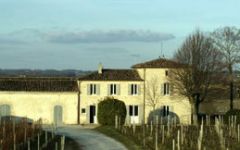Chateau Valandraud 1994
-
James
Suckling -
Robert
Parker -
Wine
Spectator



Product Details
Your Rating
Somm Note
Winemaker Notes
Professional Ratings
-
James Suckling
Gorgeous nose of milk chocolate with undertones of forest floor and iodine. Full and soft with silky tannins. A light green coffee and chocolate note as well.
-
Robert Parker's Wine Advocate
Tasted blind at the Valandraud vertical at the property, the 1994 Valandraud has a healthy dark garnet core, quite deep considering its age. The bouquet is well defined and fresh with cedar and tobacco-infused black fruit, quite Left Bank (Saint Julien to be precise) in style. The palate is medium-bodied with finer tannin than the previous vintage, some red and black fruit remaining, but usurped by tobacco and a light marine-like note. It feels as if it is approaching the end of its drinking plateau, but it has certainly held up extremely well and comes across decidedly classic in style. Like the 1993, how many 1994 Right Banks continue to give pleasure with such generosity?
-
Wine Spectator
Excellent concentration for the vintage, with seductive aromas and flavors of wild berry, mineral, mint and vanilla. Full-bodied, with fine, silky tannins and a caressing finish. Inviting now, but better in 1999. A rising star in St.-Emilion, and the best wine ever bottled from this estate.
Other Vintages
2022-
Jeb
Dunnuck -
James
Suckling - Decanter
-
Jeb
Dunnuck -
James
Suckling - Decanter
-
Robert
Parker
-
James
Suckling -
Jeb
Dunnuck -
Robert
Parker -
Wine
Enthusiast - Decanter
-
Wine
Spectator
-
Wine
Enthusiast -
Jeb
Dunnuck -
James
Suckling -
Robert
Parker -
Wine
Spectator
-
Jeb
Dunnuck -
James
Suckling -
Wine
Enthusiast -
Robert
Parker - Decanter
-
Wine
Spectator
-
James
Suckling - Decanter
-
Robert
Parker
-
Wine
Enthusiast -
James
Suckling -
Jeb
Dunnuck -
Wine
Spectator -
Robert
Parker
-
Wine
Enthusiast -
Robert
Parker -
Wine
Spectator -
James
Suckling
-
Jeb
Dunnuck -
James
Suckling -
Robert
Parker
-
James
Suckling -
Robert
Parker -
Wine
Enthusiast -
Wine
Spectator
-
Wine
Enthusiast -
James
Suckling -
Robert
Parker -
Wine
Spectator
-
Jeb
Dunnuck -
Wine
Spectator -
Robert
Parker -
Wine
Enthusiast
-
Robert
Parker
-
Robert
Parker -
James
Suckling -
Wine
Spectator
-
Robert
Parker
-
James
Suckling -
Robert
Parker -
Jeb
Dunnuck -
Wine
Spectator
-
Wine
Spectator
-
James
Suckling
-
Robert
Parker -
Wine
Spectator
-
Robert
Parker


In 1989, they bought a small parcel of 0.6 hectare (1.48 acres) located in a small valley near Saint Emilion between Pavie-Macquin and La Clotte. The origin of the wine name is as much geographic (Val: Vallon de Fongaban), as sentimental (Andraud: Murielle’s maiden name). Thus Chateau Valandraud was born.
Little by little, Jean-Luc and his wife purchased several other parcels of vines, and now, the domain represents a total surface of 10 hectares (24.71 acres), located in various areas of Saint Emilion. The diversity of soils and varietals permit the production of 6 different wines: Chateau Valandraud, Chateau Valandraud Casher, Virginie de Valandraud and the 3 de Valandraud (the second wine of Chateau Valandraud and Virginie de Valandraud), Blanc de Valandraud N° 1 and N° 2.
The final blending of the various parcels occurs in the month of March, following a blind tasting with the help of the world famous oenologist, Michel Rolland.

One of the world’s most classic and popular styles of red wine, Bordeaux-inspired blends have spread from their homeland in France to nearly every corner of the New World. Typically based on either Cabernet Sauvignon or Merlot and supported by Cabernet Franc, Malbec and Petit Verdot, the best of these are densely hued, fragrant, full of fruit and boast a structure that begs for cellar time. Somm Secret—Blends from Bordeaux are generally earthier compared to those from the New World, which tend to be fruit-dominant.

Marked by its historic fortified village—perhaps the prettiest in all of Bordeaux, the St-Émilion appellation, along with its neighboring village of Pomerol, are leaders in quality on the Right Bank of Bordeaux. These Merlot-dominant red wines (complemented by various amounts of Cabernet Franc and/or Cabernet Sauvignon) remain some of the most admired and collected wines of the world.
St-Émilion has the longest history in wine production in Bordeaux—longer than the Left Bank—dating back to an 8th century monk named Saint Émilion who became a hermit in one of the many limestone caves scattered throughout the area.
Today St-Émilion is made up of hundreds of independent farmers dedicated to the same thing: growing Merlot and Cabernet Franc (and tiny amounts of Cabernet Sauvignon). While always roughly the same blend, the wines of St-Émilion vary considerably depending on the soil upon which they are grown—and the soils do vary considerably throughout the region.
The chateaux with the highest classification (Premier Grand Cru Classés) are on gravel-rich soils or steep, clay-limestone hillsides. There are only four given the highest rank, called Premier Grand Cru Classés A (Chateau Cheval Blanc, Ausone, Angélus, Pavie) and 14 are Premier Grand Cru Classés B. Much of the rest of the vineyards in the appellation are on flatter land where the soils are a mix of gravel, sand and alluvial matter.
Great wines from St-Émilion will be deep in color, and might have characteristics of blackberry liqueur, black raspberry, licorice, chocolate, grilled meat, earth or truffles. They will be bold, layered and lush.
